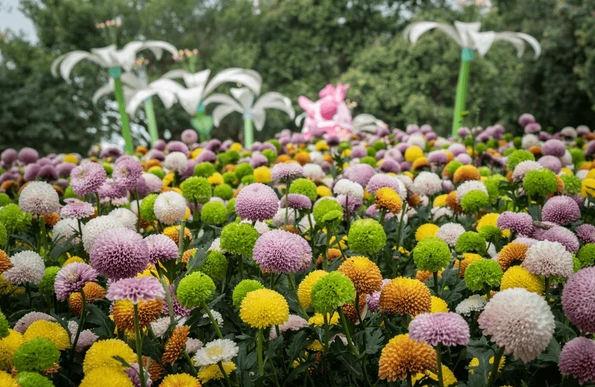
Pompon chrysanthemums also known as spray chrysanthemum are part of the Asteraceae family and are native to Asia and northeastern Europe. They have been cultivated in Japan since the 8th century, with many flower forms and colors developed over the years. These chrysanthemums are relatively small in size, with the plants grow to a height of less than 18 inches.
These flowers have tightly packed petals that form a globe-like shape, that resemble pompons, the cheering balls with handles commonly used by cheerleaders.They have a diameter of 1 to 4 inches and are known for their long vase life, which can last up to 14 to 20 days. These blooms come in colors like white, yellow, orange, pink, red, and purple. They bloom in mid-season, around October, and can last for weeks on the plant.
The Pompon chrysanthemum falls into the Class 6 category, which is characterized by globular blooms that are somewhat flat when young but fully rounded when mature. The florets of the Pompon chrysanthemum incurve or reflex regularly and fully conceal the center.
Pompon chrysanthemums are relatively easy to grow and care for. They prefer full sun and well-drained soil. They also need to be watered regularly, especially during hot weather.
Characteristics of Pompon Chrysanthemum
- Growth Form: Have a bushy, compact growth habit, with a height of about 12 to 18 inches.
- Growth Rate: They are relatively fast-growing, with ability to reach their mature size within a single growing season.
- Lifespan: As a perennial can live for several years, blooming each fall. However, they may need to be divided every few years to maintain health and vigor.
- Leaves: The leaves are dark green, ovate, and slightly serrated. They are arranged alternately along the stem.
- Flowers: They are small and spherical blooms in shape. The florets are tightly packed, giving the flower a pom-pom or button-like appearance.
- Stems: Erect, branching stems that can become woody near the base as they mature.
- Root System: Have a fibrous root system, that is relatively shallow, spreading close to the soil surface.
- USDA Zones: They are hardy in USDA zones 5 to 9, which means they can tolerate temperatures down to -20°F (-29°C).
- Sun Exposure: Prefer full sun to partial shade, with at least 6 hours of direct sunlight per day.
- Soil Requirements: They thrive in well-draining, fertile soil with a pH between 6.0 and 7.0.
- Watering: Require regular watering, especially during dry periods. The soil should be kept evenly moist, but not waterlogged.
- Pruning: To encourage bushier growth and more flowers, pompon chrysanthemums should be pruned in early summer, cutting back the stems by about one-third.
- Disease and Pest Resistance: They are relatively resistant to common diseases and pests, but they can be susceptible to aphids, spider mites, and powdery mildew.
- Companion Plants: They make excellent companion plants for other fall-blooming perennials, such as asters, sedums, and ornamental grasses.
- Propagation: They can be propagated by division in the spring or by taking stem cuttings in the summer.
Cultivation of Pompon Chrysanthemum
Planting
- Sunlight: Pompon chrysanthemums thrive in full sun, ideally at least 6 hours a day.
- Soil: They prefer well-draining soil rich in organic matter. Amending your soil with compost or peat moss before planting will help with drainage and provide nutrients.
- Timing: The best time to plant pompon chrysanthemums outdoors depends on your climate. In general, plant them after the danger of frost has passed in the spring.
- Spacing: When planting, space your pompon mums 18-24 inches apart to allow for proper growth and air circulation.
Care
- Watering: Water the plants consistently, keeping the soil evenly moist but not waterlogged. Water at the base of the plants to avoid wetting the foliage.
- Fertilizing: A balanced fertilizer applied once a month during the growing season can encourage healthy growth and flowering.
- Mulching: Apply a layer of mulch around the base of your plants to retain moisture, suppress weeds, and regulate soil temperature.
- Deadheading: Regularly deadhead (remove spent flowers) to encourage continuous blooming throughout the season.
- Pruning: Pinch back the stems occasionally during the early growth stages to promote bushier plants with more flowers.
- Division: Every 2-3 years, divide the plants in early spring to rejuvenate them and maintain vigor.